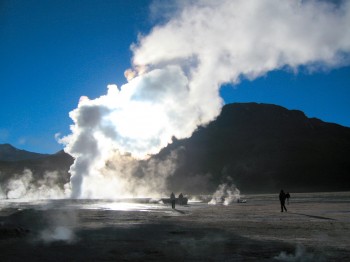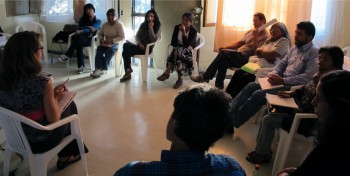El Tatio: Science for Society
November 15, 2012

Last year, Suzanne Pierce was selected as one of the first 20 Fulbright Nexus Scholars, a group of early to mid-career experts working to bridge the gap between science research and the needs of society. The program is the newest initiative of the U.S. Department of State. Pierce’s project focused on helping indigenous communities in the Atacama Desert of Chile develop strategies for sustainable use and conservation of natural resources in order to foster socioeconomic development.
When a well that was being tested by a geothermal exploration company accidentally blew out in Chile’s El Tatio Geothermal Field (ETGF), indigenous people living nearby launched a massive protest. They were concerned that the accident, which created a 60 meter tall artificial geyser and took a month to control, had permanently damaged a natural geyser field that they considered sacred and which attracts tourists from around the world. In response, the Chilean government implemented a moratorium on geothermal projects in the country. But was the decision based on science or perception?
Working with students from UT Austin’s Energy and Earth Resources graduate program and collaborators from two Chilean Universities—the Universidad de Chile and Catolica del Norte—Pierce, research assistant professor in the Jackson School, demonstrated that there was no long term damage to ETGF.
“When it comes to conflict over energy and earth resources a lot of the discussion is driven by emotion and misperception, rather than conversations, where people are fighting about it publically instead of sitting down and saying realistically what’s going on and what do we do together to make it better?” she said.
For her Fulbright Nexus project, Pierce visited with 19 indigenous community members to host a dialogue about water resource and energy issues, using techniques designed by the Department of State for conflict resolution. The indigenous stakeholders outlined goals to generate electric power and sell it to copper mine operators, start their own geothermal and groundwater monitoring network, and develop a science-based tourism industry.

Perhaps the most important outcome of discussions is that indigenous groups see the process of scientific dialogue as an opportunity to look toward a new future, one where they build capacity and knowledge about their resources. Additionally, participants are willing to learn more about geothermal energy and they are considering opening conversations with the mining and energy industries.
“How many meetings have we sat in over decades with little more than talk, talk, talk,” said Sonia Ramos, a member of the Lincanantay Indigenous community and leader in the dialogue sessions. “What we are doing here with Suzanne and her team is real and different from anything else. We are learning now and we can begin to transform our future for the better.”
As part of the project, Pierce also created ENCOMPASS, a cyber platform for scientists to share information with each other and the public. She is now developing a system for linking the data, videos and computer simulations housed on the ENCOMPASS platform with a portable, multi-touch computer table. She envisions a day when several stakeholders could stand around the table, play out various scenarios, and see the outcomes, essentially role playing different visions for the future.
“I think you have to make science accessible,” said Pierce. “Kindergartners to people who are 99 can feel comfortable discussing complex topics when the information is shown to them interactively on a touch table.”
